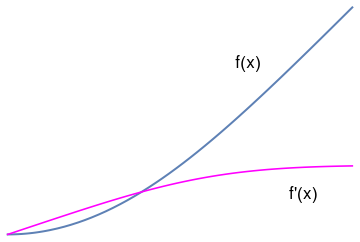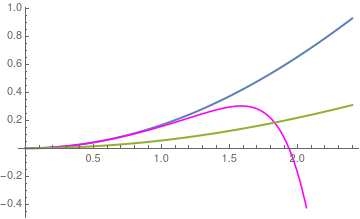Preface
This section presents some applications of Fourier transformation in heat transfer problems for unbounded domains.
Return to computing page for the second course APMA0340
Return to Mathematica tutorial for the first course APMA0330
Return to Mathematica tutorial for the second course APMA0340
Return to the main page for the first course APMA0330
Return to the main page for the second course APMA0340
Return to Part VI of the course APMA0340
Introduction to Linear Algebra
Glossary
Blasius equation
A Blasius boundary layer (named after the German fluid dynamics physicist Paul Richard Heinrich Blasius, 1883--1970) describes the steady two-dimensional laminar boundary layer that forms on a semi-infinite plate which is held parallel to a constant unidirectional flow. Upon introducing a normalized stream function f, the Blasius equation becomes
First, we start with Picard's iteration, and to achieve this we have two options: either to apply Picard's iteration directly to the third order Blasius equation directly or to convert it to a system of first-order differential equations. So we demonstrate both options, beginning with the latter.

|
blasius =
NDSolve[{f'''[x] + 1/2*f[x]*f''[x] == 0, f[0] == 0, f'[0] == 0,
f''[0] == 1/3}, f, {x, 0, 5}]
g = Plot[Evaluate[{f[x], f'[x]} /. blasius], {x, 0, 5}, PlotStyle -> {Thick, {Blue, Magenta}}] txt1 = Graphics[ Text[Style["f(x)", FontSize -> 16, Black], {3.5, 2.5}]] txt2 = Graphics[ Text[Style["f'(x)", FontSize -> 16, Black], {4.3, 0.6}]] Show[txt1, txt2, g] |
Classical Picard's iteration
In order to apply the classical Picard's iteration, we have to convert this to a system of first-order differential equations. Let
We have to provide initial guesses for f1, f2 and f3. This is the hardest part about this problem. We know that f1 starts at zero, and is flat there (f'(0)=0), but at large y, it has a constant slope of one. We will guess a simple line of slope = 1 for f1. That is correct at large y, and is zero at y = 0. If the slope of the function is constant at large y, then the values of higher derivatives must tend to zero. We choose an exponential decay as a guess.
Finally, we let a solver iteratively find a solution for us, and find the answer we want. The solver is in the pycse module.
import numpy as np
from pycse import bvp
def odefun(F, x):
f1, f2, f3 = F.T
return np.column_stack([f2,
f3,
-0.5 * f1 * f3])
def bcfun(Y):
fa, fb = Y[0, :], Y[-1, :]
return [fa[0], # f1(0) = 0
fa[1], # f2(0) = 0
1.0 - fb[1]] # f2(inf) = 1
eta = np.linspace(0, 6, 100)
f1init = eta
f2init = np.exp(-eta)
f3init = np.exp(-eta)
Finit = np.column_stack([f1init, f2init, f3init])
sol = bvp(odefun, bcfun, eta, Finit)
f1, f2, f3 = sol.T
print("f''(0) = f_3(0) = {0}".format(f3[0]))
import matplotlib.pyplot as plt
plt.plot(eta, f1)
plt.xlabel('$\eta$')
plt.ylabel('$f(\eta)$')
plt.savefig('images/blasius.png')
We get the initial second derivative to be f''(0) = 0.3324911095517483. For the sake of simplicity, we approximate the Blasius constant as 1/3.
Now we use Picard iteration procedure starting with the initial conditions. Since the derivative operator is unbounded, we apply its inverse to reduce the given initial value problem into fixed point form:
Picard's iteration applied to the third order equation
We use the fixed point formulation of the given initial value problem:
y3[x_] = Simplify[ y2[x] - 1/4*Integrate[(x - s)^2*y2[x]*1/3, {s, 0, x}]]

|
Plot[{Evaluate[{f[x]} /. blasius], y5[x], f5[x]}, {x, 0, 2.4},
PlotStyle -> {Thick, {Blue, Orange, Magenta}}]
|
Power Series Method
Adomian Decomposition Method
text goes here
- Aminikhah, Hossein, Analytical Approximation to the Solution of Nonlinear Blasius’ Viscous Flow Equation by LTNHPM, ISRN Mathematical Analysis Volume 2012, Article ID 957473, 10 pages http://dx.doi.org/10.5402/2012/957473
- Blasius, H., Grenzschichten in Flüssigkeiten mitkleiner Reibung, Zeitschrift für angewandte Mathematik und Physik (Journal of Applied Mathematics and Physics), 56:137, 1908.
- Solving the Blasius equation
- The Blasius equation, B. Bright, A. Fruchard, and T. Sari, 2010.
- Blasius equation
- Fazio, R., Transformation methods for the Blasius problem and its recent variants, Proceedings of the World Congress on Engineering, 2008 Vol IIWCE 2008, July 2 - 4, 2008, London, U.K.
- Mattioli, Franco, Blasius solution, University of Bologna, Italy.
- Parand, K., Dehghan, M., and Taghavi, A., Modified generalized Laguerre function Tau method for solving laminar viscous flow: The Blasius equation, Journal of Numerical methods for Heat & Fluid Flow, 2010, Vol. 20, Issue 7, pp.728--743, https://doi.org/10.1108/09615531011065539
- Puttkammer, P.P., Boundary Layer over a Flat Plate, University of Twenter, 2013.
- Töpfer, K., Bemerkung zu dem Aufsatz von H. Blasius: Grenzschichten in Flüssigkeiten mit kleinerReibung, Zeitschrift für angewandte Mathematik und Physik (Journal of Applied Mathematics and Physics), 60:397–398, 1912
- Treve, Y.M., On a class of solutions of the Blasius equation with applications, SIAM Journal of Applied Mathematics, 1967, Vol. 15, No. 5, 1209--1227. doi: 10.1137/0115103
- Varin, V.P., A solution of the Blasius problem, Keldysh Institute, Preprint No. 40, 2013.
- Weidman, P.D., Blasius boundary layer flow over an irregular leading edge, Physics of Fluids, 9, 1470 (1997); https://doi.org/10.1063/1.869268
- Zheng, J., Han, X., Wang, Z., Li, C., and Zhang, J., A globally convergent and closed analytical solution of the Blasius equation with beneficial applications, AIP Advances, Vol. 7, 065311 (2017); https://doi.org/10.1063/1.4985741
Return to Mathematica page
Return to the main page (APMA0340)
Return to the Part 1 Matrix Algebra
Return to the Part 2 Linear Systems of Ordinary Differential Equations
Return to the Part 3 Non-linear Systems of Ordinary Differential Equations
Return to the Part 4 Numerical Methods
Return to the Part 5 Fourier Series
Return to the Part 6 Partial Differential Equations
Return to the Part 7 Special Functions